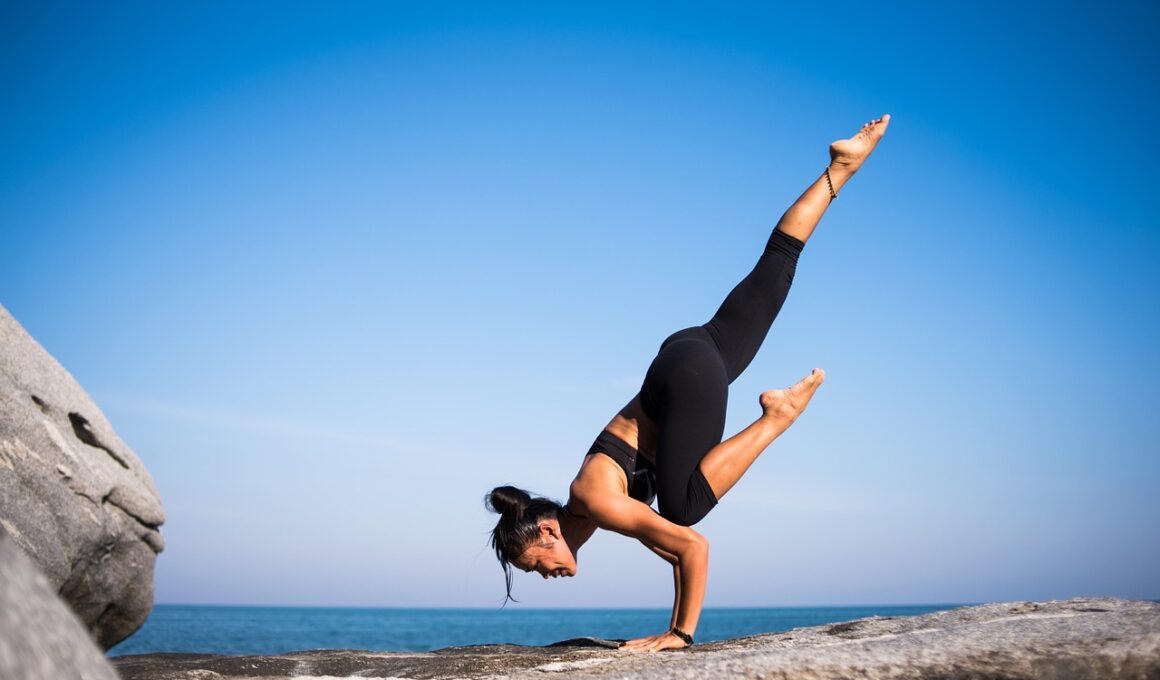Bodyweight Stability Drills to Enhance Functional Fitness
Bodyweight stability exercises are essential for enhancing core strength and improving functional fitness. These drills not only boost stability and balance but also help in engaging multiple muscle groups simultaneously. Performing bodyweight exercises regularly can lead to better overall health. You can gradually increase the complexity of your training as you become more comfortable. It’s crucial to practice these movements in a controlled manner to minimize the risk of injury. Adding stability drills to your workout regime can also improve coordination and agility. Some effective bodyweight exercises for stability include single-leg stands, planks with variations, and balance beam activities. Ensure you maintain proper form during each exercise for maximum effectiveness. Incorporating tools like the balance pad or stability ball can further heighten the challenge and aid muscle engagement. A well-rounded workout program includes a variety of movements that target different areas of the body. Prioritizing balance and stability will help in achieving functional strength and prevent falls, particularly as we age. Always listen to your body and adjust the intensity of your workouts accordingly to meet your fitness levels.
One effective bodyweight stability exercise to incorporate into your routine is the single-leg deadlift. This exercise challenges balance while targeting the hamstrings, glutes, and lower back. Start by standing on one leg, slightly bending that knee. Extend the other leg back as you lean forward, reaching towards the floor. It’s important to keep your back straight and your core engaged during the movement to maintain stability. When you reach the lowest point, hold for a second before returning to the starting position. This is a powerful drill for enhancing proprioception, which helps you become more aware of your body’s position in space. Repeat for several repetitions before switching legs. To increase the challenge, try holding a lightweight or a water bottle in the hand opposite to the standing leg. As your balance improves, you can also add a slight rotation with your torso. Another variation could involve performing the exercise on an unstable surface, such as a balance board, which further tests your stability and core engagement. Regular practice will significantly enhance your balance and lead to greater stability overall.
Plank Variations for Core Stability
The plank is a fundamental exercise that is excellent for building core strength and stability. Basic planks can be made more challenging through various modifications. Start with a standard plank on your forearms or palms, ensuring a straight line from head to heels. Once you master the basic form, consider incorporating side planks to engage the obliques more effectively. While in a plank position, lifting one leg at a time helps with lower body stability. Another variation includes the plank with shoulder taps where you alternate tapping your shoulders while maintaining the plank position. This action requires balancing on one arm and helps to improve core engagement. You may experiment with dynamic movements, such as plank jacks, to enhance coordination and challenging your stability further. The plank not only strengthens the core but also improves posture and helps prevent injuries. Incorporate these plank variations into your routine at least two to three times a week. Aim for 30-second holds or several repetitions of the dynamic ones to build endurance and strength gradually. Consistency in practicing these variations will show substantial improvement in your functional fitness.
Another beneficial bodyweight exercise is the yoga tree pose, which effectively promotes balance and stability. To get started, stand upright, shift your weight onto one leg, and lift the opposite foot to rest against your inner thigh or calf. It’s essential to avoid placing your foot directly on the knee to protect it from pressure. As you settle in the pose, bring your hands together at heart center or extend your arms overhead, creating an upward alignment. Hold the pose for 30 seconds to a minute, focusing on your breath to enhance concentration. If you prefer more challenge, you can close your eyes or perform small sways while maintaining your position. As you practice regularly, you will find improvement in both physical stability and mental focus. Yoga blends strength and flexibility, making it an excellent choice for overall well-being. Repeated exposure to balance poses like the tree pose will lead to increased awareness of body alignment. Integrating these styles into your training regimen will significantly boost your stability and emphasize the mind-body connection, further improving your overall functional fitness.
Incorporating Stability Balls
Stability balls are excellent tools for engaging muscles deep within your core during exercise routines. They allow for more dynamic movements, enhancing overall stability. Exercises like wall squats with your back against a stability ball can improve leg strength and balance. To perform this stability ball squat, place the ball between your back and a wall and squat down until your knees are aligned over your ankles, ensuring you’re not extending past your toes. Hold the position momentarily before returning to a standing position. You can also try push-ups with your feet on the ball for an advanced challenge that targets your upper body along with your core. To ensure stability, keep your core tight and maintain proper form as you lower and lift your body. Other exercises like seated ball twists, where you sit on the ball and rotate your torso from side to side, enhance core rotational strength as well. Stability balls can effectively diversify your work range, allowing great variety. Aim to incorporate them into your routine to target muscles more comprehensively, leading to improved overall functional fitness, strength, and stability.
A good way to enhance your body coordination and stability is through balance beam training. Many gyms or fitness studios might have access to balance beams or similar apparatuses designed to test your stability skills. The basic exercise involves walking across the beam, focusing on maintaining your balance without falling off. As you become more comfortable, try performing various movements along the beam, such as sideways steps or even balancing on one leg. These drills require coordination, strength, and focus synergistically working together. Balance beam training stimulates various muscle groups that are seldom employed during traditional exercises. It can also serve as an excellent way to improve your neurological responses to balance challenges. Integrating these movements into your routine can lead to considerable improvements in real-world situations, such as navigating uneven surfaces, essential for athletic performance and daily activities alike. Aim to spend several minutes practicing balance on a beam regularly, progressively increasing durations and difficulty as your stability develops. This focused effort will yield substantial benefits and increase your confidence during physical activities.
Conclusion and Tips for Success
To enhance your balance and stability effectively, consistency and mindfulness play key roles. Incorporate the discussed exercises into a balanced fitness plan, ensuring to target various muscles each session. Set aside time weekly for these stability and balance drills, allowing your body to adapt to the demands. Integrating different modalities, such as yoga or stability balls, can yield important benefits and keep routines enjoyable. Try setting achievable goals for your practice, gradually increasing duration and complexity over time. Remember to listen to your body and never push past pain thresholds; maintaining proper form is essential. Monitoring your progress through journaling or recording videos can also provide insight into your growth. Focus on the quality of movements rather than quantity, ensuring control throughout each action. Moreover, pair these exercises with good rest, hydration, and nutrition to facilitate recovery and results. Work on building a supportive fitness community around you for encouragement. By applying these tips, you’ll not only see improvements in your functional fitness but also overall physical wellness, creating a well-rounded health approach that fosters longevity and resilience.
Incorporating balance and stability exercises into your training schedule boosts not only your functional fitness but also contributes to overall well-being. These exercises are particularly beneficial in developing the core stability essential for everyday activities and sports. Start by examining your current fitness level and determining which exercises align best with your goals. Whether you are just beginning or looking to enhance your skills, choose modifications that allow you to progress gradually. In your practice, focus on maintaining awareness of your body and its movement patterns. This self-awareness fosters better technique and reduces injury risks. Utilize mirrors or record yourself to monitor form, as this can lend insight for improvement. In addition to the physical aspects, engage in mental practices, such as visualization techniques, to bolster your confidence during challenging tasks. Combining mental and physical training yields significant benefits and increases the effectiveness of your workout. Stay committed to consistency, as results unfold over time with dedication. Regularly challenge yourself while remaining safe and aware during workouts, and you will find balance and stability becoming second nature in your daily life.


